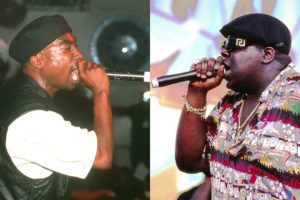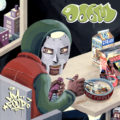
Public rivalry: The ultimate art crime. Christopher Wallace and Tupac Shakur, popularly known as The Notorious B.I.G and Tupac respectively, changed the genre of hip-hop forever and for the best. Only born a year apart, both rappers made music that spoke on the struggles many African American faced in the late 80s and 90’s due to drugs, gang violence, police brutality, and overall inequality in America. Born in New York City, both rappers gained fame in the area of gangsta rap representing two sides of the same coin, west coast vs east coast rap. As their rivalry was a national spectacle, most forget that the two rappers started off as friends. Meeting in 1993, the two had a general respect for each other’s craft, with sources claiming that Biggie often saw Tupac as a mentor and someone to turn to for advice. But once Tupac was gunned down and shot at in NYC on his way to attend a meeting between the two and after he joined Death Row Records, their feud grew and was constantly seen in their lyrics.
But while their rivalry might be a fun spectacle to participate in as a fan, was it worth it? To support pitting two of hip-hop’s most beloved artists, arguably the greatest artist of all time, against each other? After the attempt on his life, Tupac’s “All Eyez On Me” album shifted away from street politics. They focused more on gang activity specifically toward his rival Biggie and the east coast rap scene. Similarly, Biggie released diss tracks aimed at Tupac and west coast rappers. The feud was not only seen in them as individuals but mostly stemmed from their labels, Death Row Records (Tupac) and Bad Boy Records (Biggie).
In 1996 Tupac Shakur was murdered in a drive-by shooting and six months later, so was Biggie Smalls. Both murders are unsolved but to most, their deaths have a clear link to their rivalry. Yet this situation is not a unique one. Today we often hear about rappers and hip-hop artists that are constantly killed, gunned down, and shot at due to differences with one another or outside players not involved in the music industry. Looking back at hip-hop over the years, beef is something that has always stayed prominent. Cardi B vs Nicki Minaj, Nas vs Jay-Z, Drake vs Meek Mill. Recently, Migos band member Kirsnick Khari Ball, known as Takeoff, was shot and killed in Houston. As interesting as it might be to look at these public feuds and side with your favorite artist, these feuds have a track record of literally killing the art and artist. Although in most of these situations we as fans might not know the whole story, I strongly think we need to hold these artists accountable for moving past specific issues they have with each other and focus more on curating the art that they put out along with its impact. One of the reasons that hip-hop is such an influential genre is because of how it tackles social justice issues and highlights the daily socio-economic inequalities citizens in the country face, specifically African Americans and minorities. It allows their struggles to reach the ears of people and communities that would rather stay ignorant of these issues and instills a type of social consciousness. Yet, public feuds and rivalries limit this message, taking up space on albums to take shots at one another.
If you google either Tupac or Biggie right now, one of the questions in the “People also ask” section on the google search engine is “Who was bigger Tupac or Biggie”. Why does this matter? Truth is, it doesn’t and shouldn’t. Our interest as fans in this feud, whether we want to believe it or not, helped fueled it. And the result? Two of the most powerful and influential voices in hip-hop were taken away too soon.







Hi Kaylin!
I like your take on this because I hadn’t thought about this in much detail before. Although it is true that these artists don’t help minorities realize the issues that are going on by instead using songs as diss tracks, we must also accept the fact that we are also partly at fault. If the fans didn’t engage as much with the diss tracks or show interest in these rivalries, but instead made them know that they were not happy with their behavior, there could be a difference in their music. The artists would probably not release as many diss tracks and realize that they are not making music for the same purpose that they used to make it for, which was for the people and their communities.
I like your take on this because I hadn’t thought about this in much detail before. Although it is true that these artists don’t help minorities realize the issues that are going on by instead using songs as diss tracks, we must also accept the fact that we are also partly at fault. If the fans didn’t engage as much with the diss tracks or show interest in these rivalries, but instead made them know that they were not happy with their behavior, there could be a difference in their music. The artists would probably not release as many diss tracks and realize that they are not making music for the same purpose that they used to make it for, which was for the people and their communities.